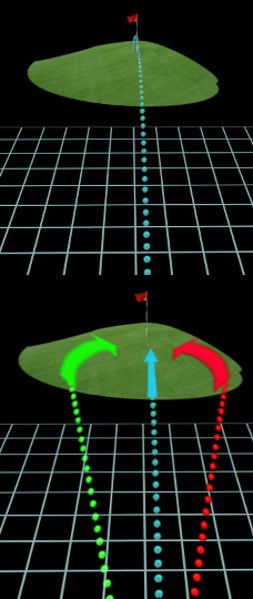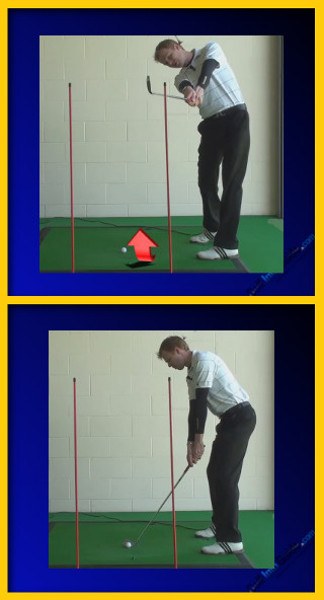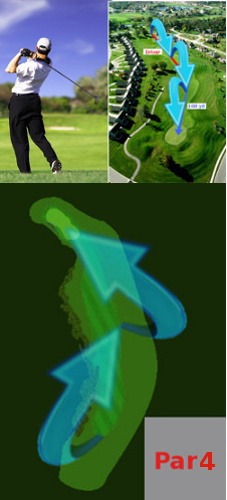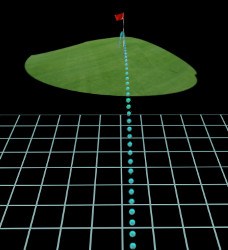
Here's the dictionary definition of straight: “Extending or proceeding in one single direction, without bends, curves, irregularities, or deviations.”
Excluding the wedges, how often do you hit a full shot that fits that description? Practically never, right? But you probably harbor this thought all the time: 'I sure would like to hit the ball straighter.
The problem is, your goal is all but unattainable. Ben Hogan himself said so. Instead, what you want to improve is your accuracy. It may seem like a semantic difference, but the distinction is important. By attempting to make the ball fly in a straight line, you decrease your margin of error and invite frustration. Accuracy is about where the ball finishes, not how it gets there.
Forget about ball flight and focus on the target. Let's say that's the middle of the fairway. There are three basic shots that will achieve the goal: 1) A straight one; 2) One that starts left of center and curves to the right; and 3) One that starts right of center and curves left. Chances are, either 2 or 3 is your natural shot shape.
Golf is hard enough without trying to hit the ball dead straight. Doing so requires both a swing and a clubface that are precisely aligned with the target at impact, which is not only difficult to pull off, it's entirely unnecessary. Often, it's even counterproductive.
For example, say you've got a 6-iron shot to a flag placed behind a bunker on the right side of the green; there's an opening left of the trap through which you can run the ball onto the green. To get it close with a straight shot, you'd have to aim right at the pin, hope to carry the bunker and stop the ball quickly. On the other hand, a left-to-right shot played away from the bunker reduces risk; it will curve and bounce toward the flag.
Bottom line: Stop trying to hit the ball straight. Use your natural shot shape, be it a fade or draw, by aiming wide of targets and letting the ball turn toward them. It's both easier and more effective.

Should You Try to Hit the Ball Straight?
It seems like the answer to the question that was posed in the title of this article should be a no-brainer. Should you try to hit the golf ball straight? Of course, right? Who wouldn't love to hit the ball straight down the middle of the fairway, time after time? A straight shot is almost always going to be a successful shot, as long as you have picked a smart target and aimed successfully at that target. If you were given the ability to hit the ball straight from the first tee on through to the last hole, you would almost certainly shoot a great score.
So why is this a question in the first place? Well, hitting the golf ball straight isn't just something that is hard to do – it is nearly impossible. Almost every golf shot that is hit in this game, no matter who is hitting it, is going to curve at least slightly in one direction or the other. You will see completely straight shots from time to time, but those are always going to be the exception rather than the rule. Golf is a game that is usually played by curving the ball in toward the target, which is why there is some debate as to whether or not you should even try to hit the ball straight.
One of the most important things you can do in your golf game is to have a plan for each shot that you hit. Before you stand over the ball to prepare for your swing, you should already have a clear plan in mind for the shot in front of you. Which club are you going to use? Are you going to hit the ball high, or low? Is the shot going to curve from left to right, or right to left? All of these questions, and more, need to be answered before you will have a comprehensive plan that you can use to guide your swing.
So, ultimately, the question that this article is going to answer comes down to this – should hitting the ball straight be an option in your mind as you prepare for a shot? In other words, should you ever aim directly at the target in the hopes of hitting a perfectly straight ball, or should you always be planning on curving the ball toward your target? In the content below, we are going to take a closer look at this topic. Strategic planning and course management are big pieces of the puzzle when it comes to posting low scores, so don't take this issue for granted. You need to have a clear idea of how you are going to navigate your ball around the course, and coming to a determination on whether or not you should try to hit the ball straight is a part of the overall course management issue.
All of the content included below has been written from the perspective of a right handed golfer. If you happen to play left handed, please take a moment to reverse the directions as necessary.

The Challenge
Before deciding whether or not you should try to hit the ball straight, let's take a look at why it is so hard to hit a golf ball straight in the first place. When you a golf shot of any significant length – say, 100 yards or more – the club is going to be moving at a significant speed through the hitting area. For instance, when talking about a drive that is going to fly more than 250 yards in the air, you are likely dealing with a swing speed in excess of 100 miles per hour. To go along with that speed, the club face is rapidly closing at it moves through the hitting area. The face is open to the line on the way down, and it quickly closes up at you near the ball, hopefully finding a square position right at the moment of impact.
Already, it should be pretty easy to see why it is difficult to hit a straight golf shot. To hit the ball straight, you have to be swinging directly down your target line at the moment of impact, and the club face has to be perfect square to the target. Oh, and you have to achieve those feats while the club is moving more than 100 miles per hour (in some cases). Is it possible to make all of this happen? Sure, it's possible. Is it likely? Not at all. Most of the time, there will be one piece of this equation that is at least a little bit off the mark, causing the ball to turn slightly in the air as it flies. From professional golfers all the way on down to total beginners, almost every shot you see hit is going to have some degree of curve between its original location at the spot when it comes back down to earth.
It should be noted that this conversation really only applies to shots hit from more than 100 yards or so. The task of hitting the ball straight becomes far easier as you get closer to the target, so playing a straight shot from inside 100 yards is very much a realistic possibility. At that point, you are going to be using a lofted club and you won't be swinging very hard. There is going to be a high rate of backspin on these shorter shots, meaning less side spin will be affecting the ball as it flies. When you get within close range of the hole, feel free to forget about curving the ball and instead take dead aim at the target.
If you aren't yet convinced of how difficult it is to hit a straight golf shot, simply head out to your local driving range and give it a try for yourself. After you work through the following drill, you should be completely convinced that hitting the ball straight is one of the hardest things you will ever try to do.
- Take your five iron from the bag and set down 10 range balls in front of you that can be hit one after the next. If you don't carry a five iron in your set, use whatever club you have replaced your five iron with, such as a hybrid or a lofted fairway wood.
- Pick out a target somewhere on the range that is approximately the right distance for the club you are holding. If necessary, set an extra club down on the ground to help with alignment to make sure you are set up directly at that target before you swing. Since you are going to be attempting to hit the ball straight, it is important that you aim directly at the target you have picked out.
- With your setup complete, go ahead and hit the first shot. Watch the shot carefully at it flies – what is it doing in the air? Is it actually flying straight, or is it turning to the left or right?
- Proceed to hit all 10 balls that you are using for this drill, and watch each one carefully as it flies. When the drill is finished, count up how many of the ten shots you think you actually hit straight.
So, how did you do? Most likely, you only hit one or two balls straight (at the most), while the rest had some degree of curve. Do you think you should be planning on hitting the ball straight when you can only do so 10 or 20% of the time on the driving range? Probably not. This is where many golfers go wrong, as they think that hitting one or two straight shots on the range is proof that they can do it. Sure, you might be able to hit one straight on occasion, but that doesn't mean you should plan on it. Hitting a shot with a curve is far more likely than hitting a straight ball, so it is the curve that you should expect while out on the course.

Playing the Angles
We have already established that it is extremely difficult to hit the golf ball straight. However, what if you did have that ability? Would you even want to use it on the course? You might not. Although it sounds desirable to be able to hit the ball straight on command – and it could certainly be useful in some cases – there is actually a lot to be said for the advantages gained by curving the ball in toward the target.
When you curve your shots intentionally, you create an angle that you can use to your advantage. That angle would not be available to you if you were to hit the ball directly at the target using a straight ball flight. Since golf courses feature all kinds of various obstacles and hazards to get in your way, using the angle created by a curved shot is a big help. This concept will be best illustrated by an example, which is offered below.
- Imagine that you are facing a long approach shot into the green of a difficult par four. You have hit a good drive, placing your ball in the middle of the fairway for this second shot. However, you still have 180 yards to the hole, meaning you are going to have to hit a quality shot if you would like to set up a birdie putt.
- The hole is cut on the left side of the green, only a few steps from the edge. That edge is guarded by a deep bunker, meaning your ball would only need to wind up a few yards to the left of the hole to find big trouble. Playing your third shot from that bunker would almost certainly result in a bogey (or worse).
- To the right of the hole, however, there is plenty of green to work with. There are no hazards to the right of the green, so a miss on that side would mean you would face a relatively easy chip shot and you would have plenty of green to work with.
So, what would be the best option for a ball flight in this case? Attempting to hit the ball straight might seem attractive, as you could take dead aim and fire away. However, that is going to leave you with very little margin for error, as that bunker is waiting to catch any shot that is pulled just slightly. On the other hand, you could opt to hit a draw from right to left in toward the target. This kind of shot would start out over the wide side of the green, taking the risk of the left bunker largely out of play. If the shot curves properly, you could bring the ball in close for a birdie chance. If it hangs straighter, you are still going to be just fine, and should have an easy chance at your par.
As you can see, in the case of the example above, it would actually be better to curve the ball than hit it straight. The curve is going to allow you to use an angle to stay away from trouble, where a straight shot would require you to cut it close if you want to set up a birdie chance. When controlled, curved shots are not just acceptable, but they are actually preferable to straight shots.

The Two-Way Miss
There is another issue with trying to hit straight shots that becomes a problem from a course management standpoint. If you are attempting to hit the ball directly at the target with any degree of curve, you will have little to no way of knowing which direction you are likely to miss. It is always possible that you are going to miss any shot that you take, so you need to plan for those misses to the greatest extent possible. This is one of the underrated skills that is possessed by the average professional golfer. Sure, pro golfers are great at hitting their targets, but they are also adept at managing their misses. By missing in the 'right spot', a pro can avoid disaster and stay on track toward a low round.
The concept of not knowing which way you are likely to err on a given shot is known in the golf world as a 'two-way miss'. Basically, that means that you could miss in either direction on a given shot, so you have no way to strategically plan around your potential mistake. A golfer who knows which way he or she is likely to miss can make smarter decisions than someone who is dealing with an ongoing two-way miss. For instance, if you know that you are prone to missing the ball to the left, and there is a hazard on the left side of the fairway, you can aim right for safety. Of course, aiming right isn't a good idea if you are just as likely to miss right as you are left. Only when you have a good feel for your pattern of misses can you really make smart, beneficial course management choices.
This is another reason why it is such a good idea to opt for a curve instead of an attempted straight shot. When playing an intentional curve, you will have a much better idea of where you are likely to miss the shot, if you do miss. Will you be able to predict the outcome of all of your shots perfectly? No – of course not. Golf is a hard game, and there is always going to be some degree of unpredictability to what takes place on the course. However, by playing an intentional curve, you can have a better idea of whether the ball is likely to miss to the right or left of the target you have selected.
It will be helpful to illustrate this point with the use of another example. This time, let's imagine that you are hitting a tee shot, and that the fairway is stretched out in front of you in a straight line (in other words, there is no dogleg to worry about). Down the right side of the fairway is a series of bunkers, and on the left side of the fairway is a large pond. Obviously, with trouble lurking on both sides, this is setting up to be a tough tee shot. Fortunately, by using a curve, you can mostly take one side of the hole out of play, giving you a better chance at success.
The first step in the process of planning this shot properly is to think about where you would like your ball to end up. Obviously, the most-desirable spot is right in the middle of the fairway. However, you also need to think about potential misses. If you fail to hit the fairway, would you rather miss to the right or the left? Well, there are bunkers right and a water hazard to the left, so right is going to be the preferred miss. If you don't hit the fairway, missing to the right will at least allow you to avoid a penalty shot and potentially still save your par.
Knowing that right is better than left, the smart shot here is to aim down the right side of the fairway while trying to play a slight draw. If the ball draws properly, you will be in the fairway and you can move on to the next shot. If the ball holds straight, you may wind up in the bunkers – but that still isn't a terrible outcome. The worst option, putting your ball in the water, is only going to happen if you make a bad swing and hook your ball quickly into the pond. Simply by making smart choices and using a curved flight to your advantage, you will have taken much of the risk out of an otherwise scary shot.

The Verdict
As you can certainly tell by this point in the article, the recommendation is to not attempt to hit your golf ball straight (on shots of more than 100 yards, at least). Not only is it incredibly difficult to hit the ball straight with a full swing, but there are also advantages to intentionally curving your shots. Curved ball flights are more useful than straight shots, and they are easier to produce in the first place. Professional golfers consistently attempt to curve their shots because that is the easiest way to play the game, and you should be doing the same.
On the driving range, work hard not on trying to hit straight shots, but rather on mastering your control over curved trajectories. While it would be ideal to have the ability to curve the ball in either direction on command, start out by refining your control over your preferred shot. Whether you favor a draw or a fade in your game, take time to master that flight before moving on to others. As long as you can hit at least one kind of curve with consistency, you should be able to work your way around most golf courses that you encounter.
It is nice to imagine a world where you could simply hit the ball perfectly straight time after time, but that world doesn't exist in the game of golf. And, if it did, the game might quickly get rather boring. It is the curving of the ball that provides the game with much of its interest and excitement, as you have to be creative as you move around the course in order to keep your ball in position. When you consider the difficult of hitting the ball straight in addition to the advantages that curves provide, you should be able to move on from this topic without so much as a second thought. Forget about straight shots and embrace the challenge of curving the ball in toward your target on each and every swing. Good luck!






